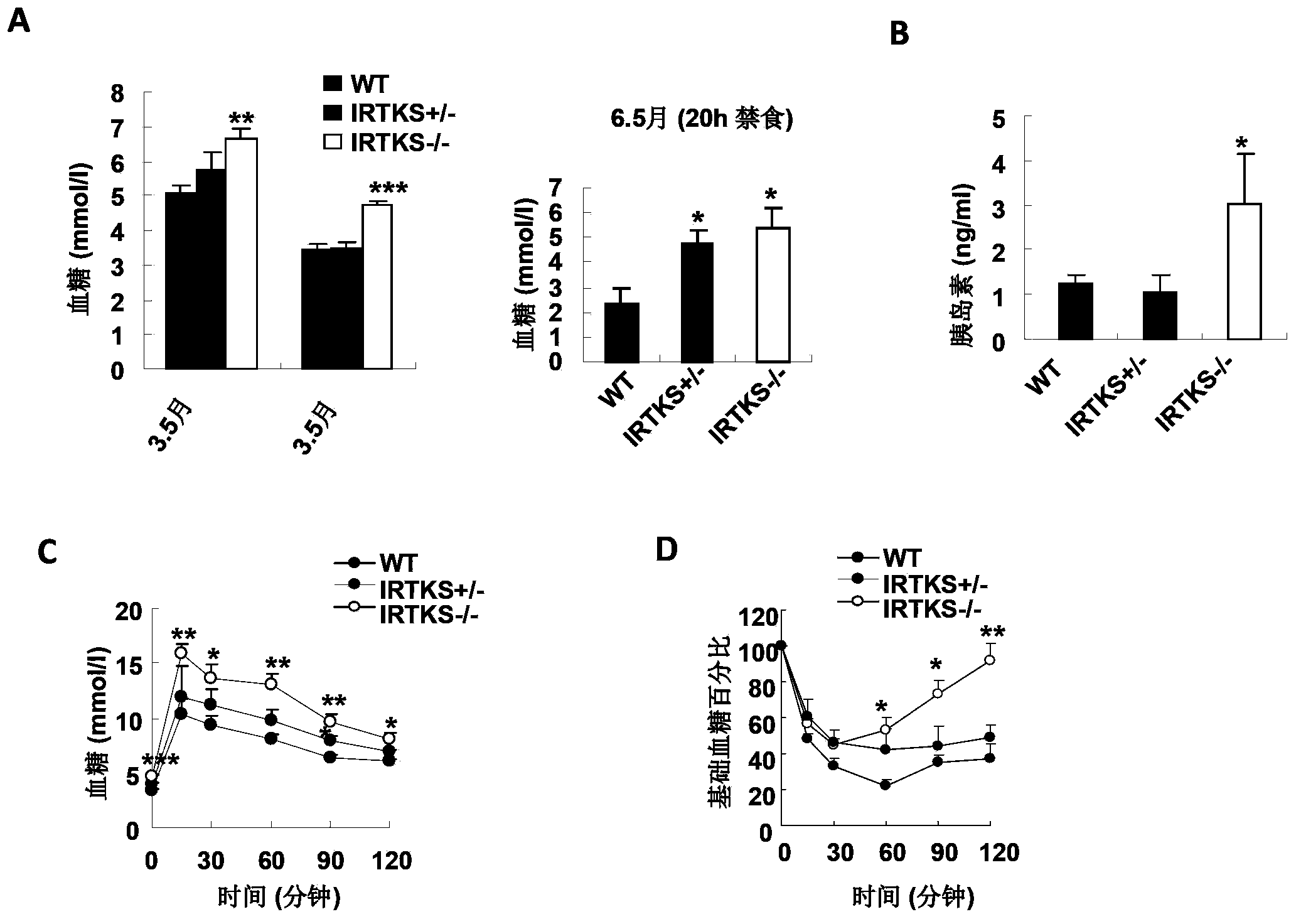IRTKS gene-knocked out mouse model, construction method and application thereof
A technology of mouse model and construction method, which is applied in the fields of application, genetic engineering, plant gene improvement, etc., can solve the problems of human diabetes deviation, matching animal models, etc.
- Summary
- Abstract
- Description
- Claims
- Application Information
AI Technical Summary
Problems solved by technology
Method used
Image
Examples
Embodiment 1I
[0019] The construction of embodiment 1IRTKS-KO mice
[0020] 1. Construction of IRTKS-KO plasmid
[0021] see figure 1 (A), 80 μg of IRTKS KO Vector plasmid DNA was digested with NotI (enzyme dosage: 100U), digested in a volume of 200 μl, and digested overnight at 37°C; gel separation and purification, gel recovery kit using QIA quick Gel Extraction Kit (Cat No. .28706); followed by ethanol precipitation and resuspended in 100 μl sterile PBS (phosphate buffered saline).
[0022] 2. ES cell targeting and screening
[0023] The above-mentioned IRTKS-KO linearized plasmid was used for ES cell targeting.
[0024] ES cells (embryonic stem cells): SCR012
[0025] DNA amount: 35μg
[0026] Electrotransfer instrument model: Bio-Rad Gene Pulser (Cat.No.165-2105)
[0027] Electroporation conditions: set voltage 240V, capacitance 500μF, actual power-on time 10.5ms, actual voltage 256V
[0028] Cloning screening conditions: 300 μg / ml G418, 2 μM GanC screening for 8 days
[0029...
Embodiment 2I
[0047] Example 2 Genotype identification of IRTKS-KO mice and expression identification of IRTKS
[0048] 1. Genotyping homozygous, heterozygous, and wild-type mice
[0049] First, design two pairs of PCR identification primers to identify homozygous, heterozygous and wild mice, see figure 2 (A). The primer sequences are as follows:
[0050] F1: CTGCGGGCTGTTAAAGGTTA (SEQ ID No: 5)
[0051] F2: ACTCAGCGCTTGAGACTTG (SEQ ID No: 6)
[0052] F3: GATCTGCCAAGGAAAGACA (SEQ ID No: 7)
[0053] F4: GGGAACTTCCTGACTAGGG (SEQ ID No: 8)
[0054] PCR reaction system (50 μl): 5 units / μl TaKaRa rTaq 0.25 μl, 10×TaKaRa rTaq buffer 5 μl, dNTP mixed solution (each concentration 2.5 mM) 4 μl, DNA template 500 ng or less, forward primer and reverse primer 0.2- 1.0 μM, make up the volume to 50 μl with sterilized distilled water.
[0055] PCR reaction conditions: 95°C for 10 minutes; 95°C for 10 seconds, 59°C for 30 seconds, 72°C for 40 seconds, a total of 33 cycles; 72°C for 5 minutes.
[0...
Embodiment 3 3
[0069] Example 3 Analysis of glucose metabolism in three groups of mice (male homozygous, heterozygous, wild)
[0070] 1. The fasting blood glucose of IRTKS-KO (IRTKS gene knockout homozygous), IRTKS-WT (wild type) and IRTKS-HET (heterozygous) mice was detected by Roche Accu-chek, and the results are shown in image 3 (A);
[0071] 2. After 3.5-month-old mice were fasted for 6 hours, 50 μl-100 μl of blood was collected by orbital puncture, centrifuged at 5000 rpm for 5 minutes, and the supernatant was taken, and IRTKS was detected with the mouse insulin ELISA kit (Cat#EZRMI-13K) of Millipore Company -KO, IRTKS-WT and IRTKS-HET mice serum insulin values, see the results image 3 (B);
[0072] 3. 3.5-month-old mice were fasted overnight, and 1.5g / kg glucose was injected intraperitoneally with a 1ml syringe at six time points before injection (0) and 15, 30, 60, 90, and 120 minutes after injection. The blood glucose value of each mouse was measured, and the mean and standard ...
PUM
 Login to View More
Login to View More Abstract
Description
Claims
Application Information
 Login to View More
Login to View More - R&D
- Intellectual Property
- Life Sciences
- Materials
- Tech Scout
- Unparalleled Data Quality
- Higher Quality Content
- 60% Fewer Hallucinations
Browse by: Latest US Patents, China's latest patents, Technical Efficacy Thesaurus, Application Domain, Technology Topic, Popular Technical Reports.
© 2025 PatSnap. All rights reserved.Legal|Privacy policy|Modern Slavery Act Transparency Statement|Sitemap|About US| Contact US: help@patsnap.com



